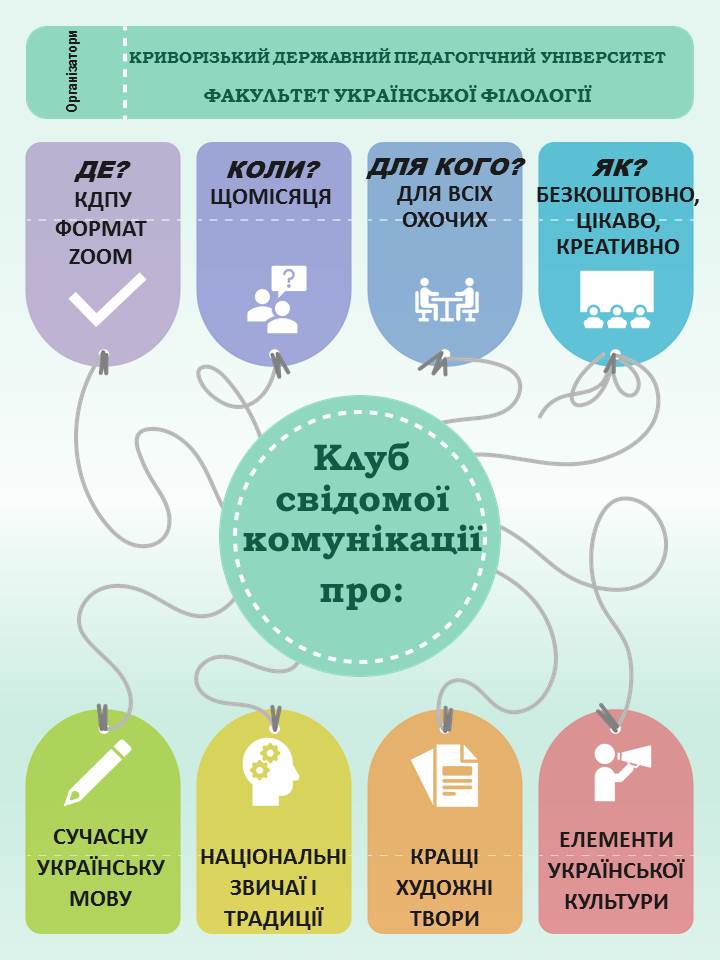Методичні рекомендації щодо самостійної роботи з другої (англійської) мови впродовж виробничої практики у школі для студентів денного відділення факультету іноземних мов освітнього рівня "магістр" спеціальностей 014 Середня освіта (Мова і література німецька), 014 Середня освіта (Мова і література російська)
Методичні рекомендації
-
-
Автор: Кафедра англійської філології
-
Перегляди: 1354
8517
Кандидат педагогічних наук, старший викладач кафедри англійської філології - Пальчикова О. О. опублікувала монографію «Навчання іноземних мов: крос-культурний підхід». У монографії розроблено теоретичні та методичні засади упровадження крос-культурного підходу до навчання іноземних мов. Визначальна особливість пропонованої методики полягає у формуванні мовної особистості, яка прагне: зіставляти відмінні аспекти рідної та нерідної мов, культур задля запобігання різноманітних бар’єрів, що перешкоджають повноцінному розумінню й коректному відтворенню інформації в іншомовному культурному середовищі; послуговуватися культурно маркованими одиницями в межах певного контексту; коректно вживати вербальні й невербальні засоби передачі інформації; реалізовувати стиль поведінки відповідно до соціального статусу особи або певної ситуації тощо. Теоретичну і прикладну цінність має лінгводидактичний інструментарій (обʼєднання ефективних методів, прийомів, форм і засобів навчання). Монографія призначена для науковців, аспірантів, викладачів закладів вищої освіти, магістрантів, студентів-філологів, учителів-словесників, усіх тих, хто цікавиться проблемами навчання мови як іноземної. Ознайомитись з монографією можна за посиланням.
-
-
Автор: Кафедра англійської філології
-
Перегляди: 318
24953
Завдання для перевірки самостійної роботи студентів немовних спеціальностей - І рівень, спеціальності РАФ - І-ІІ рівні, спеціальності АНФ - І-ІІ-ІІІ рівні
Граматичний посібник (завантажити)
Практичний посібник (завантажити)
-
-
Автор: Кафедра англійської філології
-
Перегляди: 718
4570
ЗНО з англійської мови: особливості тесту 2018 року
- Якщо учасник тестування отримує оцінку 0 тестових балів за критерій а. Змістове наповнення, то в такому випадку вся робота оцінується в 0 тестових балів.
- Якщо учасник тестування отримує оцінку 0 тестових балів за критерій с. Використання лексики або d. Використання граматики, то в такому випадку вся робота оцінується в 0 тестових балів.
- Якщо учасник тестування не приступав до виконання завдання, власне висловлювання вважається ненаписаним і вся робота оцінюється в 0 тестових балів.
-
-
Автор: Кафедра англійської філології
-
Перегляди: 820
4091
І. Особистісна сфера
- Повсякденне життя і його проблеми.
- Сім’я. Родинні стосунки.
- Характер людини.
- Режим дня.
- Здоровий спосіб життя.
- Дружба, любов.
- Стосунки з однолітками. В колективі.
- Світ захоплень.
- Дозвілля. Відпочинок.
- Особистісні пріоритети.
- Плани на майбутнє. Вибір професії.
-
-
Автор: Кафедра англійської філології
-
Перегляди: 862
4090
The examiner will listen carefully to your answers and will assess your speaking according to the following criteria.
| Criteria |
What do these criteria mean? |
| Fluency and Coherence |
Do you speak in a fluent way that is easy to understand? Do you link your ideas together clearly? |
| Lexical Resource |
Can you accurately use or attempt to use a wide range of vocabulary accurately and effectively? Can you explain your ideas even if you do not know a particular word? Can you use or attempt to use higher-level vocabulary accurately? |
| Grammatical Range and Accuracy |
Can you use a wide range of grammatical structures rather than repeating basic structures? Are your sentences accurate, or do you often make grammatical mistakes? |
| Pronunciation |
Is your spoken language clear and easily understood? Do you use stress and intonation to add extra meaning? With individual words, do you use stress accurately? |
-
-
Автор: Анна
-
Перегляди: 416
875
In the first paragraph, you should state the topic and/or your opinion, and you may include one or more of the following techniques.
• Make reference to an unusual or striking idea/scene/situation
e.g. Imagine millions of people coming home from school or work every day to sit staring at a wall for four hours.
-
-
Автор: Анна
-
Перегляди: 514
840















